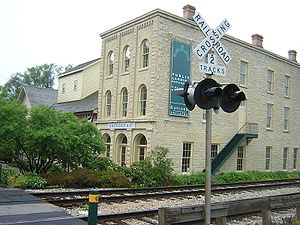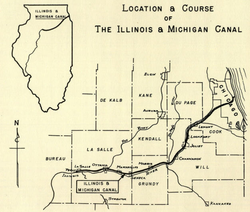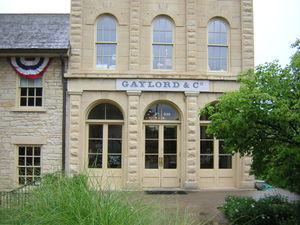
Gaylord Building
Encyclopedia

Lockport Historic District
The Lockport Historic District, also known as the Canal and Downtown Area, is a set of fifty-nine buildings in Joliet, Illinois. Of these, fifty-six contribute to the historical integrity of the area. The downtown district of Lockport was platted in 1836, the same year that construction began on...
of Lockport, Illinois
Lockport, Illinois
Lockport is a city in Will County, Illinois, United States, that incorporated in 1853. Lockport is located in northeastern Illinois, 30 miles southwest of Chicago, and north of Joliet, at locks connecting Chicago Sanitary and Ship Canal with the Des Plaines River via the Lockport...
, and on the canalside there, played a pivotal role in the construction of the Illinois and Michigan Canal
Illinois and Michigan Canal
The Illinois and Michigan Canal ran from the Bridgeport neighborhood in Chicago on the Chicago River to LaSalle-Peru, Illinois, on the Illinois River. It was finished in 1848 when Chicago Mayor James Hutchinson Woodworth presided over its opening; and it allowed boat transportation from the Great...
. It is on the United States National Register of Historic Places
National Register of Historic Places
The National Register of Historic Places is the United States government's official list of districts, sites, buildings, structures, and objects deemed worthy of preservation...
, and is one of 29 Historic Sites of the National Trust for Historic Preservation
National Trust for Historic Preservation
The National Trust for Historic Preservation is an American member-supported organization that was founded in 1949 by congressional charter to support preservation of historic buildings and neighborhoods through a range of programs and activities, including the publication of Preservation...
. It is constructed of yellow limestone
Limestone
Limestone is a sedimentary rock composed largely of the minerals calcite and aragonite, which are different crystal forms of calcium carbonate . Many limestones are composed from skeletal fragments of marine organisms such as coral or foraminifera....
, a common construction material in north central Illinois. It has an Italianate three story addition added in 1859. After falling into disrepair, it was the focus of a concerted restoration and preservation effort that began in 1983, which was later noted as setting a model for such efforts.
Background and construction

Illinois and Michigan Canal
The Illinois and Michigan Canal ran from the Bridgeport neighborhood in Chicago on the Chicago River to LaSalle-Peru, Illinois, on the Illinois River. It was finished in 1848 when Chicago Mayor James Hutchinson Woodworth presided over its opening; and it allowed boat transportation from the Great...
, begun in 1836 and finished in 1848, and spanning 96 miles (154 km), was the last link in a waterway connecting the Great Lakes
Great Lakes
The Great Lakes are a collection of freshwater lakes located in northeastern North America, on the Canada – United States border. Consisting of Lakes Superior, Michigan, Huron, Erie, and Ontario, they form the largest group of freshwater lakes on Earth by total surface, coming in second by volume...
, the Gulf of Mexico
Gulf of Mexico
The Gulf of Mexico is a partially landlocked ocean basin largely surrounded by the North American continent and the island of Cuba. It is bounded on the northeast, north and northwest by the Gulf Coast of the United States, on the southwest and south by Mexico, and on the southeast by Cuba. In...
via the Port of New Orleans and the Atlantic Ocean
Atlantic Ocean
The Atlantic Ocean is the second-largest of the world's oceanic divisions. With a total area of about , it covers approximately 20% of the Earth's surface and about 26% of its water surface area...
via the Port of New York
New York
New York is a state in the Northeastern region of the United States. It is the nation's third most populous state. New York is bordered by New Jersey and Pennsylvania to the south, and by Connecticut, Massachusetts and Vermont to the east...
. Lockport, situated about 1/3 of the way from the starting point (the Bridgeport
Bridgeport, Chicago
Bridgeport, one of 77 community areas of Chicago, is a neighborhood located on the city's South Side. It is bounded, generally, on the west and north by the Chicago River, on the east by Canal Street, and on the south by Pershing Road.-History:...
neighborhood in Chicago on the Chicago River
Chicago River
The Chicago River is a system of rivers and canals with a combined length of that runs through the city of the same name, including its center . Though not especially long, the river is notable for being the reason why Chicago became an important location, as the link between the Great Lakes and...
) and the end point (LaSalle, Illinois on the Illinois River
Illinois River
The Illinois River is a principal tributary of the Mississippi River, approximately long, in the State of Illinois. The river drains a large section of central Illinois, with a drainage basin of . This river was important among Native Americans and early French traders as the principal water route...
), was a natural location for canal planning, staging and warehousing operations. The I&M canal headquarters were thus in Lockport.
Little progress on canal construction was made during the first two years,due to difficulties in securing supplies and manpower, most of which had to be brought from the East Coast. In the 1830s, this far west, most areas, even a few miles out from major settlements such as Chicago, were essentially wilderness, and Lockport had no warehouse
large enough to house all the materials shipped in to foster canal construction, so the canal authorities decided to build one. There was some controversy at the time over the use of state funds to pay for it.
The choice of material used, given the frontier nature of the town, was surprising to some. However this area of Illinois has large deposits of yellow limestone, in some cases just below the surface. Some sources say the building uses some stone taken directly from the canal excavation.
The building was constructed between May and September 1838 under the supervision of two brothers, Erastus and William Newton, who were contractors on the I&M Canal, at a cost of USD $4,014.29, a substantial sum at the time. Use of yellow limestone may have started a trend.
Warehouse

The 1859 addition was in a significantly different style. The property continued to change hands, going through many uses, as a warehouse, machine shop, foundry, printing facility, and finally (with an addition of a third story on the original section) a plumbing supply warehouse.
Restoration
In 1983 Gaylord Donnelley, George Gaylord's multimillionaire grandson and the retired chairman of Chicago’s R. R. Donnelley & Sons publishing house, became interested in the building (reportedly on the urging of his niece). He formed a private development company, The Gaylord Lockport Company, named for Donnelley’s grandfather, and spent four years and $2.8 million restoring the derelict building to its former beauty, including removing the third story and restoring the roofline as it was in 1859.At the same time, impetus was growing for the creation of a Heritage Corridor
Heritage Corridor
The Heritage Corridor Line is a commuter rail line provided and operated by Metra in Chicago, Illinois, and its surrounding suburbs. While Metra does not specifically refer to any of its lines by a particular color, the timetable accents for the Heritage Corridor line are printed in dark "Alton...
to document, preserve and interpret the I&M Canal, and in 1984 President Ronald Reagan
Ronald Reagan
Ronald Wilson Reagan was the 40th President of the United States , the 33rd Governor of California and, prior to that, a radio, film and television actor....
signed the legislation to create it. In 1987 the building opened to the public, featuring the Public Landing restaurant and a museum featuring canal exhibits. Reagan recognized the Gaylord Building and the project by personally presenting Mr. Donnelley with a President’s Award for Historic Preservation, and the project and became a model for preserving historic sites for new uses.
Management and location
The National Trust for Historic Preservation now owns the Gaylord Building Historic Site and the Canal Corridor Association manages it as part of the Lockport National Historic District. The building is a hub of canal exhibits, tours and programs. The canal trail runs past the building along the old canal towpath, and it leads visitors to other parts of historic downtown Lockport, including the Norton Building, home to the Illinois State Museum Lockport Gallery.

